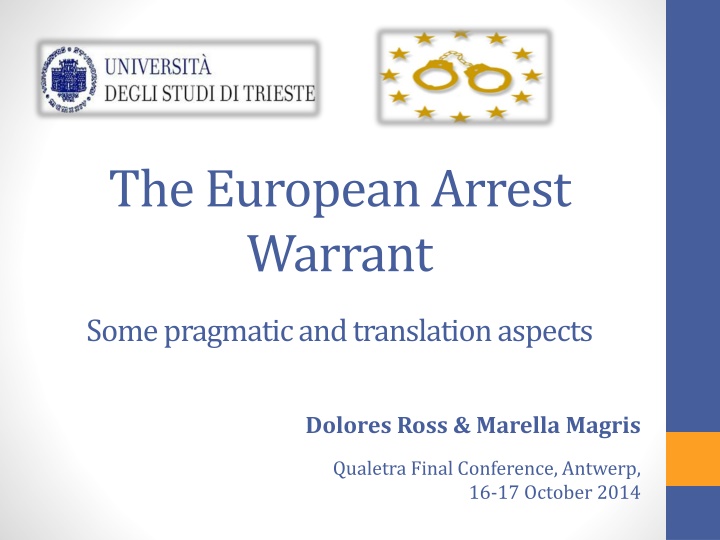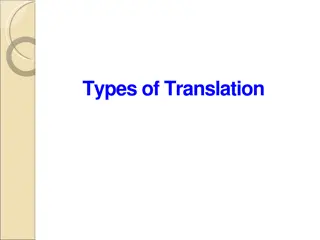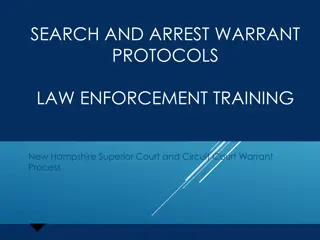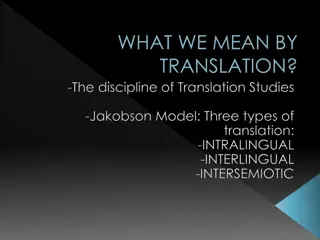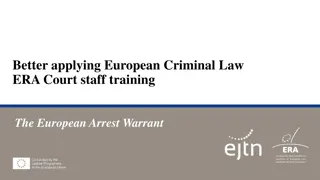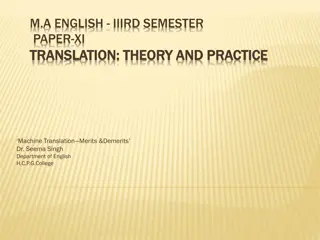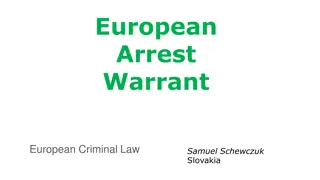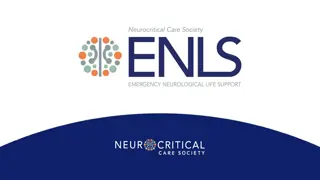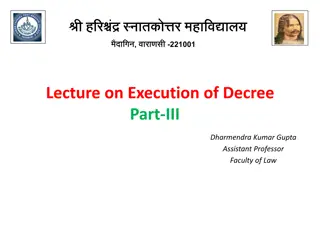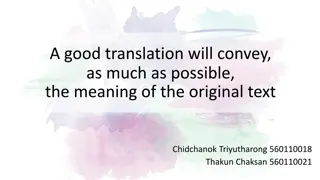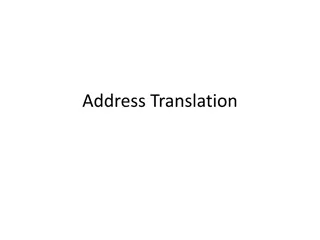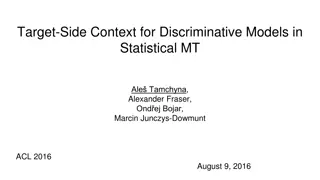The European Arrest Warrant: Pragmatic and Translation Aspects
Exploring the European Arrest Warrant (EAW) in Belgium and Italy, this presentation delves into structural and linguistic indicators, judicial core terminology, participants in EAW communication, translation best practices, and the role of legal translators in ensuring quality. Discover the innovative aspects of EAW implementation, standard form characteristics, and challenges related to core legal terminology across different languages.
Download Presentation

Please find below an Image/Link to download the presentation.
The content on the website is provided AS IS for your information and personal use only. It may not be sold, licensed, or shared on other websites without obtaining consent from the author.If you encounter any issues during the download, it is possible that the publisher has removed the file from their server.
You are allowed to download the files provided on this website for personal or commercial use, subject to the condition that they are used lawfully. All files are the property of their respective owners.
The content on the website is provided AS IS for your information and personal use only. It may not be sold, licensed, or shared on other websites without obtaining consent from the author.
E N D
Presentation Transcript
The European Arrest Warrant Some pragmatic and translation aspects Dolores Ross & Marella Magris Qualetra Final Conference, Antwerp, 16-17 October 2014
Presentation 1. The EAW in Belgium and Italy 2. The EAW standard form: structural indicators 3. Linguistic indicators: Judicial core terminology Lexical features: conservatism and redundancy Basic syntactic parameters Discourse indicators and discursive strategies 4. Participants in the EAW communication situation 5. Translation of the EAW: best practices and quality assurance 6. Legal translators in Belgium and Italy 7. Concluding remarks
1. EAW in Belgium and Italy Belgium: law of 19th December 2003 Italy: law n. 69 of 22 April 2005 Most innovative aspect: the EAW is a purely judicial matter, it takes the decision for surrendering out of the hands of politicians. Italy: Ministry of Justice centralises transmission and reception EAW
1. EAW in Belgium and Italy After a few years of teething problems concerning conflict with national constitutional laws, all member states [ ] are using the instrument and it is thriving. In 2007 the European Commission declared the EAW as a success (JUSTICE 2012: 7).
2. The EAW standard form: structural indicators Art. 8 FD: all Member States use identical form and content. 9 sections: a i. Section d, Legal Guarantees (NL juridische garanties, IT garanzie giuridiche) and section e, Offences (NL strafbare feiten, IT reati).
3. Linguistic indicators of the EAW in Belgian Dutch and Italian 3.1 Judicial core terminology Legal terminology is the most visible and striking linguistic feature of legal language as a technical language, and it is also one of the major sources of difficulty in translating legal documents (Cao 2007: 53).
3.1 Judicial core terminology Name: Europees aanhoudingsbevel, Europees arrestatiebevel EAB Mandato di arresto europeo MAE Verb: uitleveren (extradite) -> overleveren (surrender) consegnare
3.1 Judicial core terminology Legal professions and court structures: Parket van de procureur des konings BC kamer bij de correctionele rechtbank Rechtbank van eerste aanleg Procura della Repubblica presso il Tribunale Procuratore della Repubblica, Sostituto Procuratore della Repubblica Gip Gup
3.1 Judicial core terminology Suspect/requested person de gezochte persoon - la persona ricercata de betrokkene - l interessato beklaagde - l imputato de veroordeelde persoon - il condannato Defence lawyer raadsman/advocaat difensore/avvocato Judicial decision: vonnis/beslissing decisione (giudiziaria) /provvedimento
3.2 Lexical features: conservatism and redundancy Conservative character of legal language: at vocabulary level: archaic terms and expressions at syntactic level: obsolete clauses and constructions at discourse level: old-fashioned cohesive devices
3.2 Lexical features: conservatism and redundancy ARCHAISMS NL in voorkomend geval, een tegensprekelijk debat, stuiting van de verjaring IT in specie. ARCHAIC FUNCTION WORDS NL indien, betreffende, dewelke IT ove, ivi, stante
3.2 Lexical features: conservatism and redundancy LATINISMS Latin has had a pervasive influence on most legal languages a large proportion of the vocabulary of modern legal languages comes from the legal Latin used in Antiquity, the Middle Ages, or the beginning of the Modern Era (Mattila 2013: 173-4; Tiersma 2008: 12). Latin still possesses high status in the Western world and is being widely used as a stylistic tool with a display function. NL: modus operandi, IT: in absentia
3.2 Lexical features: conservatism and redundancy THE FRENCH HERITAGE The French language has had great prestige and importance in legal language, and the French Civil Code had a tremendous impact throughout continental Europe (Tiersma 2012: 18). For historical reasons Belgium has been strongly influenced by the French language and culture, and this is clearly manifested in the legal language too (Hendrickx 1999: 20-21). perhaps the main difference in legal style between the two Dutch sublanguages.
3.2 Lexical features: conservatism and redundancy REPETITIONS AND SYNONYMS Outstanding position of legal English, richly endowed with binary formulae, triplets and other words strings (Mattila 2013, etc.). Function: solemnity, dignity, over-cautionousness NL moord en doodslag (murder) IT omicidio volontario NL vrijheidsstraf of tot vrijheidsbeneming strekkende maatregel IT pena o misura di sicurezza privative della libert
3.3 Basic syntactic parameters: long and complex sentence constructions Among the most obvious syntactic features of legal language is the use of extremely long sentences (Tiersma 2008: 15). Sentences with complex clausal structure, embedded clauses, etc. The layman citizen who wants to explore his rights in judicial documents is often confronted with an unreadable text (Renkema 2004: 258).
3.3 Basic syntactic parameters: long and complex sentence constructions Dutch example: Het verzet is een rechtsmiddel waardoor aan een partij, ten aanzien van dewelke door een vonnisgerecht in eerste aanleg of in graad van hoger beroep uitspraak werd gedaan bij verstek, de mogelijkheid geboden wordt om de zaak opnieuw aanhangig te maken bij het vonnisgerecht dat uitspraak deed, teneinde de beslissing te horen intrekken en de zaak andermaal, na een tegensprekelijk debat, te doen beoordelen.
3.3 Basic syntactic parameters: long and complex sentence constructions Italian: [ ] veniva condannata in Italia alla pena di anni 6 di reclusione, oltre la pena accessoria perch ritenuta responsabile della violazione degli artt. 74 commi 1, 2, 4, e 5 della l. 685/75 ed art. 74 commi 1, 2, 3, 4 DPR 309/90, per aver, in concorso con altri soggetti di nazionalit italiana, fatto parte di un associazione finalizzata al traffico illecito di sostanze stupefacenti del tipo eroina, cocaina, extasy ed hashish, l organizzazione della quale la condannata faceva parte gestiva il mercato della droga in Milano [ ]
3.3 Basic syntactic parameters: long and complex sentence constructions importando ingenti quantitativi dello stupefacente dai paesi di produzione, la droga veniva poi confezionata negli Stati Uniti d America e smerciata in Italia, in specie [ ] era diretta fiduciaria del correo [ ] gestiva i proventi del traffico internazionale degli stupefacenti, ed era la destinataria di tutti i messaggi funzionali all attivit operativa dell organizzazione durante la detenzione di [ ] organizzazione armata composta da pi di dieci persone operante in Milano dalla fine del 1970 al 1993.
3.3. Basic syntactic parameters: clause- internal features PARTICIPLE SYNTAX NL Verkrachting zijnde elke daad van seksuele penetratie van welke aard ook en met welk middel ook, op een persoon die daar niet in toestemt, de daad met name opgedrongen zijnde door middel van geweld, dwang of list of mogelijk gemaakt zijnde door een onvolwaardigheid of een lichamelijk of geestelijk gebrek van het slachtoffer. IT .. organizzazione armata composta da pi di dieci persone operante in Milano dalla fine del 1970 al 1993
3.3 Basic syntactic parameters: passive voice and nominal style Both passive and nominal constructions promote an impersonal style. Judges and legislators tend to speak in the third person. EAW introductory paragraph: NL Ik verzoek om aanhouding en overlevering van de hieronder genoemde persoon met het oog op strafvervolging of tenuitvoerlegging van een vrijheidsstraf IT Chiedo che la persona menzionata appresso sia arresta e consegnata ai fini dell espiazione della pena privativa della libert .
3.4 Discourse indicators and discursive strategies NL dit bevel IT il presente (mandato), tale (tali garanzie), siffatto (siffatta pena). Differences in discursive practices in Belgian Dutch: Op X december bleef het 15-jarig slachtoffer samen met haar moeder overnachten bij hun tante. XXX was daar eveneens aanwezig en wordt beschouwd als nonkel . Iedereen sliep in de living.
Summarizing 3.3-3.4 Typical syntactic and discourse features in the Belgian and Italian EAWs: long and complex sentences, embedding constructions, a high degree of participle syntax, passive voice in Italian. Need for plain language principles (Mattila 2012: 33, Tiersma 2008: 24). NL een beklaagde die [ ] niet zelf of vertegenwoordigd door zijn raadsman is verschenen, kan [ ] in zijn afwezigheid veroordeeld worden [ bij verstek ].
4. Participants in the EAW communication situation Participants Producer of the source text: judicial authority of the issuing Member State Translator Receiver: competent judicial authority of the executing Member State Person wanted for prosecution Professional relationship between the people taking part in the EAW communication activity Communicative purpose
5. Translation of the EAW: best practices and quality assurance The scarcity of translation capacity in some Member States, associated costs, difficulties in translation into some of the less common languages in short periods of time or the bad quality of translations are recurrent arguments (Evaluation Report Council European Union 2009: 10). Often, judges and prosecutors are visibly wary of the quality of translations they deal with, especially in the most common languages such as English or French (De Sousa Santos & Gomes 2010: 110-111)
5. Translation of the EAW: best practices and quality assurance Major problem - the organization or consolidation of reliable high- quality translation services at a national level and the availability of a reliable Europe-wide source of translated and original legal texts on these matters. (De Sousa Santos & Gomes 2010: 101-102). Another important issue - communication between legal practitioners and translators
5. Translation of the EAW: best practices and quality assurance Need for effective communication English translation? Up to now, translation tends to be approached in a strongly reductionist way. It is generally speaking approached as a tool , as a service (Lambert 2009: 76) Trend towards a more collaborative translation model .
5. Translation of the EAW: best practices and quality assurance Endorsement of the application of plain, legal-language principles to improve target language readability and render more elegant and useful translations (Wolff 2011: 237). the translator is gradually becoming a knowledge manager, called on to perform higher order skills of textual and discourse competence, with increasing use of genre-based competences, thereby generating intellectual capital (Risku et al., 2010: 88-89).
6. Legal translators in Belgium and Italy In Belgium, there is currently no centralised official database of interpreters and translators. There are lists of legal interpreters and translators, which are drawn up by different courts on different levels: national, regional or local (Hertog 2001: 10). In May 2014, the Belgian Parliament has approved a proposal for the creation of a national register.
6. Legal translators in Belgium and Italy Italy has no national database of translators or interpreters. This is to give the Italian judiciary the freedom to choose translators and interpreters as they see fit https://ejustice.europa.eu/content_find_a_legal_translator_or_an_interpreter-116-it- en.do?member=1 The Italian law implementing the Directive 2010/64/EU has adopted a shortcut solution: instead of creating a national register, it has only introduced the requirement that experts in translation and interpretation must be enrolled in the register of experts (Albo dei periti) maintained by each Court.
6. Legal translators in Belgium and Italy The prerequisites to enroll in these registers vary from place to place. Very heterogeneous quality levels will probably continue to characterize the field of legal translation in Italy, at least in the foreseeable future. However, translation of the EAWs is done by internal translators of the Italian Ministry of Justice
7. Concluding remarks Legal translation plays a significant role in our age of globalization where the mobility of persons, goods, services, and capital across borders has changed the dynamics of law, forcing legal professionals to communicate in a wide variety of multilingual and multicultural settings ( ar evi 2012: 187)
7. Concluding remarks For centuries the translator has been viewed as a solitary figure working in isolation, pondering over words and sentences. Within a few years his/her workplace was then transformed by terminological databanks, MT-systems, the Internet with its attendant tools and all the other technological developments that are still being updated at an ever-increasing rate (Snell-Hornby 2010: 368)
Dank u voor uw aandacht! Grazie della vostra attenzione!
References Bednarek Grazyna, 2009, Translation of the European Arrest Warrant in the Light of Intercultural Communication , Investigationes Linguisticae, vol, XVII, pp. 84-99. Cao Deborah, 2007, Translating Law, Clevedon: Multilingal matters. De Sousa Santos Boaventura & Consei ao Gomez (eds.), 2010, The European Arrest Warrant in law and in practice: a comparative study for the consolidation of the European law-enforcement area, 2010, EUEurojust, 2010, Versione riveduta del manuale europeo sull emissione del mandato d arresto europeo. Eurojust, 2011, Jaarverslag Eurojust 2010. Gotti Maurizio, 2012, Text and Genre , Lawrence M. Solan & Peter M. Tiersma (eds.), The Oxford Handbook of Language and Law, 52- 66. Hertog Erik (ed.), 2001, Aequitas. Access to Justice across Language and Culture in the EU, http://www.eulita.eu/sites/default/files/Aequitas_Acces%20to%20J ustice%20across%20Language%20and%20Culture%20in%20the%20 EU.pdf
References Hiltunen Risto, 2012, The grammar and structure of legal texts , Lawrence M. Solan & Peter M. Tiersma (eds.), The Oxford Handbook of Language and Law, 39-51. JUSTICE, 2012, European Arrest Warrants. Ensuring an effective defence. Katschinka Liese, 2013, Vademecum for users of legal translations. Kocbek Alenka, 2009, A Targeted Approach to Legal Translation , Susan ar evi (ed.), Legal language in Action : Translation, Terminology, Drafting and Procedural Issues, Zagreb: Nakladni zavod Globus, 43-62. Lambert Jos , 2009, The Status and Position of Legal Translation: a Chapter in the Discursive Construction of Societies , in: Frances Olsen, Alexander Lorz, Dieter Stein (eds.), Translation Issues in Language and Law, Palgrave Macmillan, London,76-93. Mart nez Motos Raquel & Adelina G mez G nz les-J ver, 2009, Anisomorphism in the translation of Legal Texts, in Sarcevic ed. 61-72. Mattila Heikki E.S., 2012, Legal vocabulary , Peter M. Tiersma & Lawrence M. Solan (eds), Language and Law, Oxford: Oxford University Press, 27-39.
References Mattila Heikki E.S., 2013, Comparative Legal Linguistics, Ashgate, Farnham, Surrey. Risku H., Dickinson, A., & Pircher, R. (2010). Knowledge in Translation Studies and translation practice . In D. Gile, G. Hansen, & N. Pokorn (Eds.), Why Translation Studies matters (pp. 83 94). Amsterdam: John Benjamins. ar evi Susan, 2012, Challenges to the legal translator , Lawrence M. Solan & Peter M. Tiersma (eds.), The Oxford Handbook of Language and Law, 187- 199. Snell-Hornby Mary, 2010, The turns of Translation Studies , Yves Gambier & Luc van Doorslaer (eds.), Handbook of Translation Studies, vol. 1, Amsterdam/Philadelphia: Benjamins, 366-370. Tiersma Peter M., 2008, The nature of legal language , John Gibbons & M. Teresa Turell (eds), Dimensions of forensic linguistics, Amsterdam/Philadelphia: Benjamins, 7-25. Tiersma Peter M., 2012, A history of the languages of law , Lawrence M. Solan & Peter M. Tiersma (eds.), The Oxford Handbook of Language and Law, 17- Wolff Leon, 2011, Legal Translation , in Kirsten Malmkjar & Kevin Windle (eds.), The Oxford Handbook of Translation Studies, 228-241.
